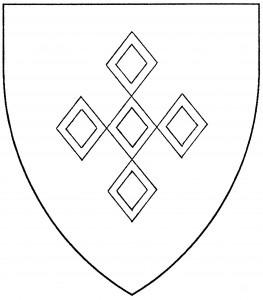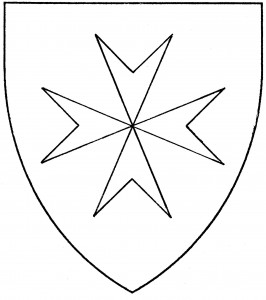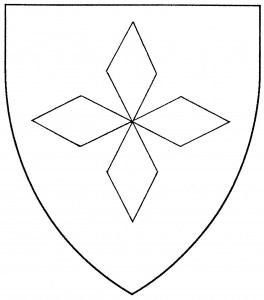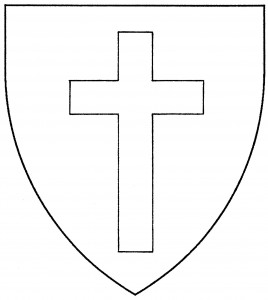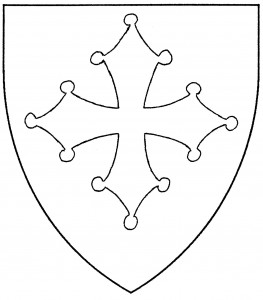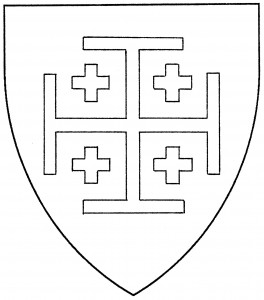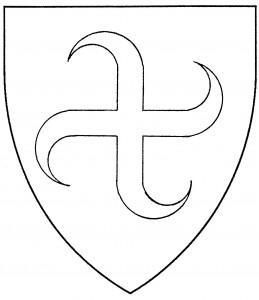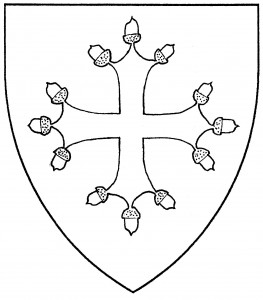The “cross of mascles”, like the cross of lozenges, must have its number explicitly blazoned. The illustration shows a cross of five mascles.
Archives
Cross: Maltese
The “Maltese cross” is the modern name for the badge of the Knights of St. John of Jerusalem, later called the Knights of Malta. Originally, it was referred to as a “cross of eight points”, with each point said to represent one of the Beatitudes [Franklyn 118]. Though the Order was founded in 1113, this badge was not used in members’ armory until the 18th Century [Volborth 199, 211]. The Maltese cross was used as part of the full achievement, as for the arms of Pope Clement VII, 1523 [Galbreath’s Papal Heraldry, p.89]; therefore, it’s permitted for use in Society armory. The limbs should each be as wide as the space between them; they should converge to a central point, or very nearly.
Emeric Wendel bears: Per pale argent and gules, a Maltese cross counterchanged.
Marcus Carunna bears: Or, a Maltese cross purpure.
Cross: Lozenges
The “cross of lozenges”, unlike the cross of fusils, is seldom throughout. The number of lozenges must be explicitly blazoned; the illustration shows a cross of four lozenges.
Aline Blakwode bears: Argent, a cross of four lozenges vert.
Cross: Latin
The “Latin cross” is also called a “long cross” or a “Passion cross” [Parker 160]. It’s simply a cross couped with the lower limb elongated. It’s found in the arms of Cardinal Isidorus, c.1550 [BSB Cod.Icon 267:193].
Caedmon Wilson bears: Argent, three Latin crosses azure.
Faílenn inghean Mheanmain bears: Quarterly vert and argent, two Latin crosses in bend Or.
Cross: Key
The “key cross” is found in the arms of the city of Pisa, and is sometimes called a “cross of Pisa” for that reason. It was certainly in use by the mid-15th Century [Triv 7], and may have been used as early as the 13th Century.
Ian Bruce MacRae bears: Gyronny azure and gules, a key cross Or.
Cernach Mac Gilla Críst bears: Per pale azure and Or, three key crosses counterchanged.
Gregory de Munemuth bears: Vert, a key cross argent.
Cross: Jerusalem
The “cross of Jerusalem” is taken from the arms of that Kingdom. The Kingdom of Jerusalem had a variety of crosses through its life; this is the best known form, dating from 1282 [ANA2 339]. Period blazons didn’t use the term, instead explicitly blazoning it by parts, e.g., “a cross potent between four crosses couped.”
Stephan of Monmouth bears: Per pale Or and sable, a cross of Jerusalem counterchanged.
Lothar Hügelman bears: Sable, a cross of Jerusalem argent.
Lucien de Wyntere bears: Azure, a cross of Jerusalem within a bordure argent.
Cross: Humetty
The “cross humetty” is sometimes considered synonymous with the cross couped; but most writers feel they differ, in that the cross humetty is couped parallel to the edge of the shield.
Amelinne la bouchiere bears: Or, on a cross humetty sable five escallops argent.
Cross: Gurgity
The “cross gurgity” or “cross gurgitée”, while appearing in modern heraldry texts [e.g. Leonhard 291], does not seem to have been actually used in medieval armory. Due to its resemblance to modern white supremacist symbols, the cross gurgity is no longer permitted to be registered; those already registered are considered a step from period practice.
Gwynneth Sanquebarr bears: Azure, a fess argent between two crosses gurgity Or.
Uther Schiemann der Hunt bears: Gules, a cross gurgity Or within a serpent in annulo head to base argent.
Cross: Gringoly
The “cross gringoly”, or “cross gringolé”, is a cross couped with two serpent’s heads issuant from each limb. It’s found in the arms of Huyn or Hune, c.1370 [Gelre 76].
Séigíne inghean uí Dhraighnéain bears: Per bend sinister vert and Or, a cross gringolé counterchanged.
David Boot Legg bears: Or, a cross gringolé gules with serpent’s heads vert.
